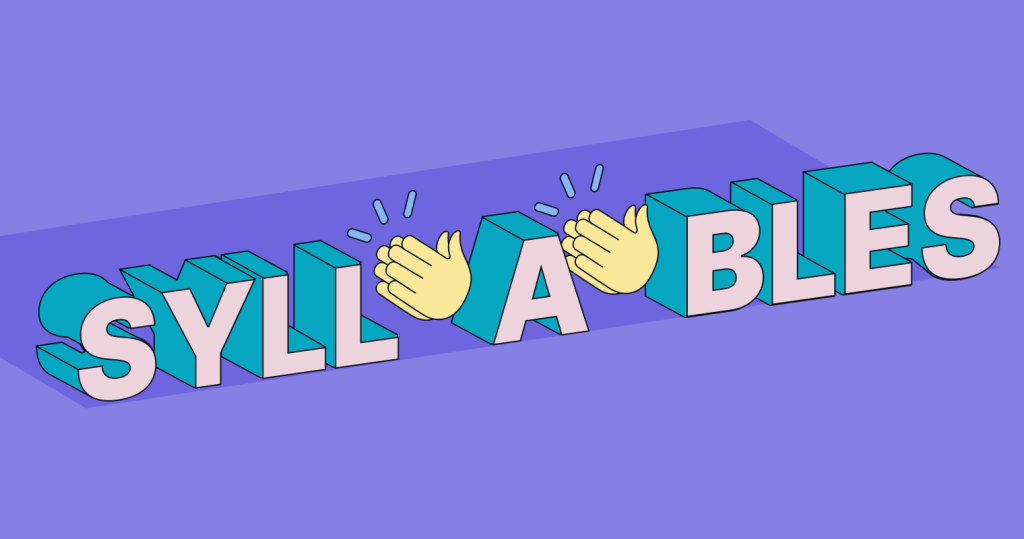This article explores effective practice exercises and resources to help students master closed-syllable words and improve reading fluency.
Research shows that targeted activities focused on closed-syllable patterns can powerfully impact the development of decoding skills and confidence in young readers.
This content covers:
- Engaging in games and hands-on activities to reinforce closed-syllable patterns
- Printable word lists for targeted practice at various skill levels
- Strategies for identifying closed syllables in longer, unfamiliar words
- Tips for incorporating closed-syllable instruction into the reading curriculum
Whether you’re a teacher looking for fresh ideas or a parent seeking to support your child’s reading development at home, these resources will equip you with the tools to help students become confident, fluent readers.
Foundational Concepts for Syllables

To effectively teach closed syllables, it’s essential to understand the specific spelling rules and patterns associated with this syllable type. Here are some key rules and their common patterns
-
/k/ Sound Spelling: The /k/ sound at the end of a closed syllable is often spelled with -ck, as in “lock” or “stick.” This spelling is reliably used when following a short vowel sound immediately.
-
/ch/ Sound Spelling: The -tch spelling for the /ch/ sound at the end of a closed syllable appears in words like “match,” “patch,” or “itch.” It’s important to note that -tch is used after a short vowel, while -ch is used after a consonant or long vowel sound.
-
/j/ Sound Spelling: The -dge spelling for the /j/ sound occurs at the end of a word following a short vowel, in examples such as “badge,” “fudge,” or “hedge.”
Helping students recognize and apply these consistent patterns will enhance their ability to decode and spell closed-syllable words accurately.
| Syllable Pattern | Example Words | Notes |
|---|---|---|
| /k/ sound | lock, stick | Spelled with -ck, it typically follows a short vowel sound. |
| /ch/ sound | match, patch, itch | It is spelled as -tch after a short vowel. The -ch spelling is used after a consonant or long vowel sound. |
| /j/ sound | badge, fudge, hedge | Spelled as -dge at the end of a word following a short vowel. |
| Unique Vowel Sounds | wild, kind, cold, bolt. | Words follow closed syllable rules but have modified vowel sounds in the -ild, -ind, -old, and -olt patterns. |
| Words ending in -st | past, fast, last | The /a/ sound in these words resembles the short /o/ sound, making them exceptions. |
| -ing and -ang | sing, bang | These endings produce unique vowel sounds that differ from the short vowel sound in closed syllables. |
While these patterns are generally consistent, addressing common exceptions that students may encounter is crucial.
- Unique Vowel Sounds: Words like “wild,” “kind,” “cold,” and “bolt” follow the closed-syllable rule of having a single vowel followed by consonants, but the vowel sound is slightly modified in the -ild, -ind, -old, and -olt patterns.
- Words Ending in -st: Words such as “past,” “fast,” or “last” where the /a/ sound is more akin to the short /o/ sound.
- Unique Spelling Patterns: -ing and -ang Words with these endings, such as “sing” or “bang,” produce a unique vowel sound that differs from the typical short vowel sound in closed syllables.
By exploring these foundational concepts in depth and providing ample examples, educators can confidently equip students with the knowledge and skills to identify, decode, and spell closed-syllable words.
Regular practice and reinforcement of these patterns and exceptions will help students develop automaticity in applying their understanding of closed syllables to their reading and writing.
Methods of Teaching Syllables to Kids
Introducing closed syllables in the classroom requires a systematic, explicit approach to ensure student success. Here’s how educators can effectively incorporate closed-syllable instruction
- Begin by clearly defining the characteristics of a closed syllable with a single vowel followed by one or more consonants, producing a short vowel sound.
- Provide examples of closed-syllable words emphasizing the vowel-consonant structure and the resulting short vowel sound, such as simple CVC (consonant-vowel-consonant) words like “cat,” “pin,” or “mud.”
1. Visual Aids and Progression
- Use visual aids, such as color-coding the vowels and consonants or underlining the syllables, to help students identify key components more easily.
- Gradually progress to more complex words that include blends (e.g., “stop,” “plan“), digraphs (e.g., “shin,” “duck“), or multiple closed syllables (e.g., “kitten,” “sunset”).
2. Multisensory Activities
- Encourage hands-on learning by having students manipulate letter tiles or magnets to build words, physically segmenting the syllables and sounds.
- Introduce tactile activities such as tracing syllables in sand, shaving cream, or paint to connect physically to the word structure.
- Utilize hand motions or tapping to represent each sound in a word, aiding in internalizing the syllable pattern.
3. Practice and Feedback
- Incorporate closed-syllable words in daily reading and writing tasks to ensure frequent practice.
- Provide immediate feedback during exercises like shared reading, guided reading, dictation, or independent work.
- Conduct regular review sessions through games or quick drills to reinforce learning.
4. Grouping Strategies for Enhanced Learning
- Implement small group instruction for targeted skill practice and personalized feedback.
- Facilitate peer-assisted learning activities, such as partner reading or word sorts, to promote collaborative learning.
- To build a learning community, engage the whole class in activities like choral reading or maintaining word walls featuring closed-syllable words.
By consistently applying these strategies and allowing for ample practice and application, educators can help students develop a solid foundation in recognizing, decoding, and spelling closed syllables.
This approach ensures that as students gain proficiency, they are well-prepared to tackle more complex words and texts confidently.
Group and Individual Activity
Mastering closed syllables is essential for developing reading and spelling proficiency.
This section provides a structured approach to enhancing closed-syllable understanding through targeted individual and group activities and advanced practices for more experienced learners.
From basic exercises like syllable identification and spelling drills to interactive group games and complex word challenges, these methods aim to reinforce learning and make the mastery of closed syllables engaging and effective.
Exercise Overview This table summarizes key exercises for mastering closed syllables, including their objectives, required tools, and expected outcomes.
| Exercise Type | Purpose | Tools Required | Expected Outcomes |
|---|---|---|---|
| Syllable Identification | To help students recognize and categorize syllable types. | Worksheets, digital activities | Improved ability to identify closed and open syllables in words. |
| Spelling and Decoding Drills | To reinforce spelling patterns and enhance decoding skills. | Letter tiles, whiteboards, flashcards | Enhanced spelling accuracy and quicker word recognition. |
| Digital Tools | To provide engaging, interactive practice for syllable work. | Educational apps, online platforms | Increased student engagement and instant feedback on performance. |
1. Individual Exercises
Syllable Identification and Marking
Engaging students in individual practice exercises is crucial for reinforcing closed-syllable skills.
One effective exercise is syllable identification and marking, where learners divide words into syllables and label each as closed or open.
- Provide worksheets or digital activities that present a variety of words, including those with single and multiple syllables.
- Students should carefully examine each word, separating and marking the closed syllables.
- This exercise helps students develop a keen eye for recognizing syllable structure and applying their knowledge of closed-syllable patterns.
Spelling and Decoding Drills
Another valuable individual practice is spelling, and decoding drills focused specifically on closed-syllable words.
Create lists of target words showcasing closed-syllable patterns, such as CVC words, words with blends or digraphs, and multisyllabic words. Students can practice spelling these words independently, using letter tiles, whiteboards, or pencil and paper.
- Encourage students to say each sound aloud as they spell, reinforcing the connection between the written and spoken word.
- For decoding practice, present the same words in a list or on flash cards and have students read them aloud.
- Timed reading exercises can add an element of challenge and help build fluency.
Engagement through Digital Tools
- Consider using digital tools or gamified activities to keep individual practice engaging.
- Many educational websites and apps offer interactive closed-syllable exercises, such as matching games, word sorts, or fill-in-the-blank tasks.
- These digital resources often provide immediate feedback and track student progress, allowing personalized learning and self-paced practice.
Integration in Daily Tasks
- In addition to these specific exercises, integrate closed-syllable words into daily independent reading and writing tasks.
- Encourage students to identify closed syllables in their self-selected texts and practice using closed-syllable words in their writing.
- Providing regular opportunities for authentic application will help students transfer their skills beyond isolated practice exercises.
2. Group Activities
Word-Building Sessions
Collaborative group activities add an element of social interaction and peer learning to closed-syllable practice.
One engaging activity is a word-building session, in which small groups of students work together to create and decode closed-syllable words. Provide each group with letter tiles or magnets, including multiple vowels and consonants.
Challenge the groups to build as many closed-syllable words as possible within a given time frame.
Encourage students to discuss their word choices and explain why each word qualifies as a closed syllable.
Closed-Syllable Word Sort
- Another interactive group activity is a closed-syllable word sort.
- Prepare a set of word cards featuring a mix of closed-syllable words and words with other syllable types. Students sort the words into categories in small groups based on their syllable structure.
- They should identify the closed-syllable words and discuss the patterns they observe, such as CVC words or words with specific consonant blends.
Gamification of Learning
- Gamifying closed-syllable practice is an effective way to engage students and promote teamwork. Adapt classic games like Bingo, Memory, or Fish to feature closed-syllable words.
- These games provide repetition and reinforcement in a fun, interactive format.
Scavenger Hunt
- To add an element of movement and exploration, create a closed-syllable Scavenger Hunt. Hide cards featuring closed-syllable words around the classroom or school building.
- Divide students into teams and challenge them to find and collect as many cards as possible within a set time limit. As teams locate each card, they must read the word aloud and explain why it is a closed syllable.
3. Advanced Practices
Multisyllabic Word Challenges
- As students gain proficiency with closed syllables, it’s important to challenge them with more advanced practices to deepen their understanding and extend their skills.
- Prepare a set of longer words that contain multiple closed syllables, such as “fantastic,” “September,” or “elephant.” Have students break these words into individual syllables, marking the closed syllables and identifying the short vowel sounds within them.
Complex Word Family Analysis
- Another advanced practice is to have students analyze the role of closed syllables within complex word families.
- For example, present a base word like “act” and challenge students to build related words by adding prefixes and suffixes, such as “actor,” “action,” “react,” or “activity.”
Use in Complex Sentences
- Incorporate complex sentence structures to extend closed-syllable practice. Provide students sentences with closed-syllable words in various positions, such as within embedded clauses or phrases.
- The content structure incorporates a blend of paragraph descriptions and bullet points for specific activities, allowing for clearer presentation and easier digestion of the material. This restructuring enhances readability and helps to emphasize key points effectively.
Assessment and Evaluation
Regular assessment is essential for monitoring students’ understanding and mastery of closed syllables. A comprehensive assessment plan should include formative and summative assessments to gather data on student progress and inform instructional decisions.
Formative assessments are ongoing, informal evaluations that provide immediate feedback on student learning.
These include
- Exit tickets: Quick checks for student understanding at the end of a lesson.
- Short quizzes: Students may be asked to identify the number of closed syllables in a set of words or to choose the correct spelling of a closed-syllable word from multiple options.
- Oral reading samples: Assess students’ ability to decode closed-syllable words accurately and fluently within connected text.
Conversely, summative assessments are more formal evaluations administered at the end of a unit or learning period to measure overall mastery. These can include
- Comprehensive tests: Featuring a mix of multiple-choice, fill-in-the-blank, and open-ended questions covering closed-syllable patterns, spelling rules, and word analysis.
- Projects or portfolios: Showcase students’ ability to apply their closed-syllable knowledge in authentic reading and writing tasks, such as creating a story or informational text featuring closed-syllable words.
When designing assessments, aligning them with the specific learning objectives and standards addressed in closed-syllable instruction is important.
Use a variety of question formats and task types to assess different levels of understanding, from basic recognition to application and analysis. Provide clear instructions and rubrics to ensure students understand the expectations and criteria for success.
Once assessments have been administered, take time to analyze the data and identify patterns in student performance. Look for common errors or misconceptions that indicate a need for reteaching or additional practice.
Use this information to guide instructional decisions, such as
- Forming small groups for targeted skill instruction.
- Designing differentiated learning activities.
In addition to formal assessments, ongoing informal observation and student self-assessment can provide valuable insights into student progress.
- Encourage students to reflect on their learning, identify areas of strength, and set goals for improvement. Provide opportunities for students to share their reflections and celebrate their growth over time.
- Implementing a comprehensive assessment plan that includes formative and summative measures can help educators gather actionable data on student learning and make informed decisions to support student success.
- Regular assessment and reflection help students develop a strong foundation in closed syllables and confidently apply their skills.
Additional Resources
Educators can curate a collection of high-quality resources for professional development and student practice to support closed-syllable instruction and extend learning beyond the classroom.
Recommended Readings
Titles like “Speech to Print Language Essentials for Teachers” by Louisa Moats and “Equipped for Reading Success” by David Kilpatrick offer deep insights into phonological awareness, orthographic mapping, and syllable types, including closed syllables.
These texts provide educators with a solid theoretical foundation and practical strategies for effective literacy instruction.
Educational Websites and Blogs
Resources such as Reading Rockets (www.readingrockets.org) and The Literacy Nest (www.theliteracynest.com) feature:
- Articles and lesson plans tailored to teaching syllable types and patterns.
- Printable resources, including word sorts and games.
- Assessment tools that can be easily incorporated into classroom practice.
Many educational blogs, authored by experienced teachers and literacy specialists, share strategies, innovative ideas, and real-world applications of effective closed-syllable instruction.
Online Platforms and Apps for Students
Websites like Starfall (www.starfall.com) and ABCya (www.abcya.com) provide
- Games and activities reinforcing syllable patterns, spelling rules, and word recognition.
- Features that allow students to progress at their own pace and receive immediate feedback.
Apps such as “Syllable Awareness” and “Syllable Word Games” focus on
- Syllable identification and manipulation skills.
- Opportunities for independent practice, center activities, or homework assignments to extend learning outside the classroom.
Evaluating Resources
Assessing additional resources for quality, relevance, and alignment with research-based practices is crucial. Look for materials that
- Provide clear, explicit instruction in closed syllables.
- Offer ample opportunities for practice and application.
- Consider your students’ needs and interests to engage and challenge them appropriately.
Educators can continually enhance their expertise in closed-syllable instruction by exploring and utilizing these resources.
Regularly sharing and discussing new finds with colleagues can foster a collaborative professional learning environment and ensure students receive the most effective, up-to-date tools and strategies for mastering closed syllables.
Final Thoughts
Mastering closed syllables is a critical stepping stone toward reading proficiency.
Understanding the patterns, rules, and exceptions associated with this fundamental syllable type helps students gain the tools and confidence to decode unfamiliar words and tackle increasingly complex texts.
The practice exercises and resources outlined in this article provide a roadmap for teachers and parents to support learners in developing a strong foundation in closed syllables.
While mastering closed syllables takes time and effort, the benefits are worth the investment.
As students internalize these patterns and develop automaticity, they unlock the door to more fluent, expressive reading and a lifelong love of learning.
So, let’s celebrate each small victory and continue working together to help every student become a skilled, confident reader.










